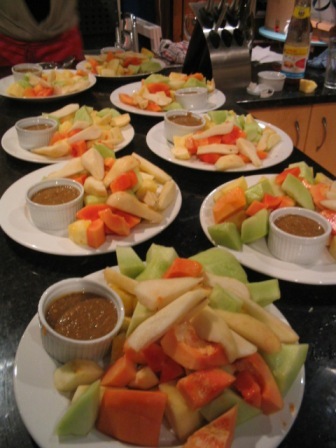Sambal Badjak
Sambal Badjak
Ingredients:
200 gr. Onions
3 cloves Garlic
12 Candle nuts
1 tsp.. Laos powder
1 tsp. Shrimp paste
3 tsp. brown Sugar
125 cc. Tamarind liquid
2 sprigs Lemon grass
25 gr. creamed Coconut
2 tbs. Oil
Salt to taste
Preparation:
Process Chillies, Onions, Garlic and Candle nuts in food processor into a coarse paste. Add Laos, Shrimp paste and sugar. Heat Oil in wok and add the mixture. Stir-fry until Onion are soft and slightly browned. Add Tamarind, Lemon grass, Coconut and Salt. Simmer until mix becomes thick and the oil floats on top. Remove Lemon grass. Let Sambal cool and then store in Jar. Refrigerate until needed. This should keep for 2-3 Months.Instead of fresh Chillies you can use the equivalent amount of Sambal Oelek. This sambal is very tasty as a replacement of the fresh Chillies in my recipe for Nasi Goreng and can be used in many more of my recipes.
Indonesian Spicy Fruit Salad (Rujak)
The spicy thick sauce is made of water, shrimp paste, peanuts and brown sugar-wait– there’s one more thing *thinking*, you may add 2 or 5 bird’s eye chili, and red chili (optional) as desired. All of fruits are sliced and put on the dish and poured with the spicy sauce. And, I usually enjoy rujak in mid day.
You may also found Rujak in Singapore and Malaysia (with different taste and style Of Course).
The complete recipes is, as follow. Enjoy!!

1 chayote, peeled
1 Granny Smith apple, cored
2 cucumbers peeled and cut in half lengthwise with seeds removed
1 raw mango
1 orange, peeled and divided into sections
½ tsp. crushed red pepper
¼ tsp. shrimp paste
3 tbsp. brown sugar
½ tsp. salt
1 tsp. tamarind, dissolved in 1 tbsp. warm water
1 14-oz. can diced pineapple, Drained
Direction:
1. Coarsely chop chayote, apple, cucumbers, mango, and orange sections.
2. In a large bowl, combine crushed red pepper, shrimp paste, brown sugar, salt, and tamarind to make a paste.
3. Add chayote, apple, cucumber, mango, orange, and pineapple to the bowl, and stir well to combine. Serve at room temperature.
Sambal Ulek (Oelek) (Javanese Chilli Paste)

Ingredients:
25 Chillies
White vinegar (see How to)
2 tsp Salt
How to:
- Wash the chillies, then just remove the stalks, but not the seeds.
- Put the whole chillies into the jar of a blender, add about 1/2 tablespoon of vinegar then blend. (Warning, don't lift the lid straight off the blender jar and look in - you could get a major hit of chilli fumes! Let it settle before opening the lid, carefully.)
- If the chilli paste is too thick and chunky, add a little more vinegar, then blend again: it should become a smooth paste.
- Then stir in the salt.
- Keep the finished chilli paste in a sterilised jar in the fridge, ready to use whenever chillies are needed in a recipe.
- This is an Indonesian style chilli paste, a great way to keep excess chillies you've harvested.
It's adapted from 'The Complete Asian Cookbook' by Charmaine Solomon. Burke's Backyard Magazine

Riau Province Gulai Blacan (Shrimp Curry)

When you see the word "Gulai" in Indonesian Dish, it's usually translated into Curry. But don't imagine that the dish always uses turmeric as traditional curry does.
Indonesian Curry dishes that use turmeric should be called "Kari". But "Gulai" dishes don't always use turmeric, as shown in the recipe below.
Ingredients:
10 large shrimp, cleanded
1 bunch petai (stinking beans), peeled
1 tbsp Java Tamarind
1 tbsp sugar
500 ml coconut milk
1 tsp salt
1/2 tsp pepper
3 tbsp cooking oil
Blend:
6 shallots
4 cloves garlic
6 pcs pecan
6 pcs red chili
6 pcs bird's eye chili
How To:
1. Heat the oil.
2. Stir fry blended ingredients until fragrant and cooked.
3. Add shrimps, continue to fry until the shrimps change color.
4. Add coconut milk, Java tamarind water, sugar, salt and pepper.
5. Cook to boil and until the solution thicken.
6. Add Petai (Stinking Beans), stir well, and dish up.
Serves 6
Indonesian Yellow Rice (Nasi Kuning)
When I was about 10 years old I spent most of my morning through midday time with my aunt in country side. She’s very good at making festive rice along with its complement Potato Fritter (perkedel kentang), crispy tempeh, and some garnishes like celery and sliced tomato.
In Indonesian tradition usually we enjoyed it during festival or in holiday such as Ramadhan. But of course you can enjoy it everytime you like.
Here is the recipe:
4 tbsp. canola oil
2 cloves garlic, minced
2 medium onions, chopped fine
1 tbsp. turmeric
1 lb. uncooked Thai fragrant rice
3 c. water
1 14-oz. can reduced-fat coconut milk
2 stalks lemongrass
1 tsp. salt
1 red chili pepper, seeded and chopped
1 medium cucumber, peeled and sliced thickly
1 tomato, cut into wedges deep-fried shallots
10 fried shrimp crackers
Direction
- In a Dutch oven, heat oil over medium heat. Add garlic, onions, and turmeric and stir-fry for 3 minutes, until onions are soft but not brown.
- Add rice and stir to coat.
- Add water, coconut milk, lemongrass, and salt. Bring mixture to a boil, stirring frequently.
- Cover, reduce heat, and simmer for about 20 minutes, or until the rice has absorbed all of the liquid.
- Remove from heat and cover pan with a dish towel. Set aside for 15 minutes.
- Remove lemongrass stalks. Mound the rice on a serving platter. Garnish with chili pepper, cucumber, tomato, fried shallots, and shrimp crackers.
Links


